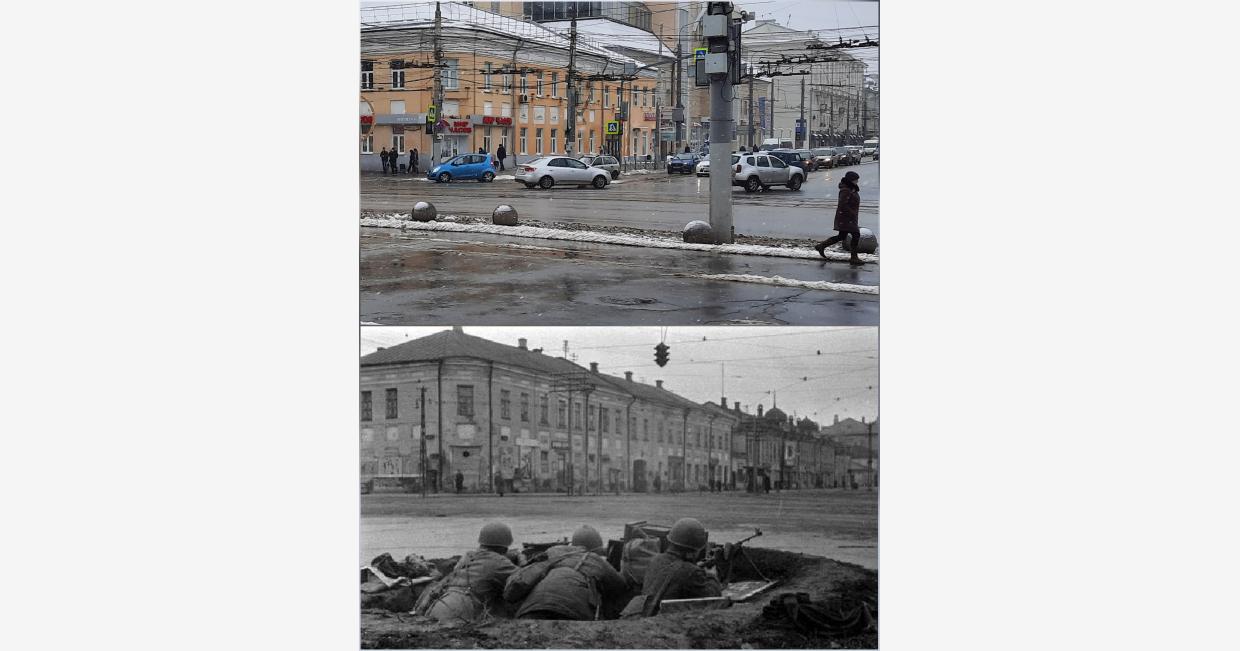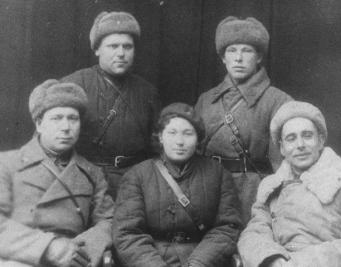Sovetskaya street, Tula. End of October, 1941 / Sovetskaya street, Tula. December 2021
Soviet soldiers with a machine gun and an anti-tank rifle in a trench facing the main street of the city.
In late October 1941 the fate of Tula was teetering on the edge. Kampfgruppe Eberbach which spearheaded Guderian's Panzergruppe 2 offensive and included around a hundred tanks supported by infantry and mechanised towed artillery, advanced to the suburbs of Tula by the end of October 1941, overcoming disorganised Soviet opposition. The city authorities failed to prepare the city for the German attack, and very few bunkers and other defenses were constructed. This gave Guderian a good reason to expect the city to fall into his hands as easily as Oryol less than a month earlier, which was abandoned by Soviet troops after a small clash near the city's airport.
The troops which defended the city were inferior to the German attackers in all respects: in armaments, in training and in numbers. All they could do was steel their desperate resolve and hope for the reinforcements to arrive in time. By the time Oberst Eberbach ordered to start the attack at dawn's break on October 30th, the Soviet troops that manned the freshly dug trenches were the 156th NKVD Regiment, and the Tula Workers' Regiment - an ad-hoc unit made up of factory personnel with little to no training. Nearly all of the city's anti-aircraft guns were redeployed to fire at German tank in a direct fire mode. After falling under the trademark hurricane of fire and steel of a 1941 Wehrmacht offensive, Tula workers who saw military action for the first time wavered and fled to the rears. However, the more disciplined NKVD units held their ground, suppressed the panic and helped the militiamen to reorganise themselves. The 47 ton KV-1 tanks that appeared just in time helped the troops win back some of the lost ground and the 85mm AA guns continued exacting their punishment on the Panzers. By the end of the day the Germans pushed the defenders back in many places but failed to approach the borders of the city's historical center. The next day newly arrived reinforcements not only allowed the Soviet troops to hold out against German attacks but also push the enemy back in a few places. Over the course of this fighting several dozen German tanks and about three hundred soldiers were destroyed, however the defenders suffered grievous losses as well, the Worker's Regiment being severely decimated. By the end of day on November 1st, having realised the city would not be an easy prize to seize, Guderian abandoned his active attempts to storm into the city and decided to bypass city in order to encircle it later.
From the diary of Senior Lieutenant Vasily Afanasievich Benzel, chief of staff of the Tula Workers' Regiment:
"October 30, 31 and November 1st were the decisive days of the fight for Tula, the days when Guderian's armoured gangs were repulsed. The days of struggle I haven't witnessed before.
People armed with rifles and hand grenades, supported by an insignificant amount of artillery, pushed back up to 4 attacks of armoured units which numbered from 20 to 100 vehicles. The attacks have been stopped, the city is ours. Dedication and tenacity of our soldiers and officers carried the day.
... the fire of 4 AA guns we had in our sector was not a serious impediment for the tanks. They drove up in close proximity of our units calmly and methodically, crushed our soldiers under their tracks and shot them with their machine guns. A part of the soldiers of the Workers' Regiment wavered and abandoned their positions, and the 2nd Battalion of the 156th Rifle Regiment fled in panic. In the sector of the Workers' Regiment where there were no anti-tank obstacles all 34 enemy tanks broke through into the Osoaviakhim park and approached the church. Enemy at the gates of the city and in the rears of our command center. A battalion of enemy submachine gunners followed their tanks...
The situation is serious and threatening. I've got a call from the Tula Combat Sector command that they are going to blow up a bridge across the river Upa. According to the reports of newly arrived soldiers the city is descending into chaos with public disorders, looting and overall panic. The situation in the Sector is so dire that some commanders (in particular, Chief of Artillery Colonel Baskin) suggested to move the command center deeper into the city, but this meant precipitating the flight of all defending units and surrendering the city... All of us who arrived with the 956th Rifle Regiment, decided not to make a single step back and to do everything possible to repel enemy assaults..."
Senior Lieutenant V.A. Benzel would be killed in action near Yukhnov on 28.04.1942.

